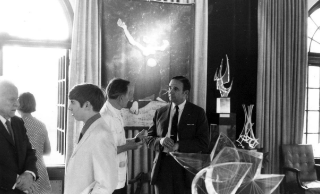✕
Our journey: The evolution of the Burroughs campus

Enrollment: 339 in 1950 & 396 in 1959
Distinctions: 12 National Merit Finalists & 1 Scholar
Distinctions: 12 National Merit Finalists & 1 Scholar
Program Highlights
- In May 1950, the Board announced the adoption of a full scale pension plan for teachers and staff.
- In 1951, Mr. Gaylord Montgomery made the recommendation that Burroughs start a summer camp. The Board agreed and Mr. Tom McConnell, then head of the Physical Education Department, launched Burr-Oak Camp in the summer of 1952 with 37 campers ages 7-12. It reached an enrollment of 275 campers in 1961.
- In 1952, enrollment was 357 and 11 percent of students were receiving some form of tuition aid; down from 17% in 1942.
- The defeat of the famed Puxico Indians in 1953 to claim Burroughs’ first (and only!) boys State basketball championship capped a remarkable five-year run for the team.
- In 1955, the Board of Trustees and the faculty affirmed a policy of non-discrimination on the basis of color or creed.
- On Halloween in 1959, Burroughs football defeated the Jefferson City Jays 13-0. This was the last loss by the Jays before their 71-game winning streak over 7 ½ years. The Jays barely squeaked by JBS in the 1959 return match on Leland Field. Jeff City brought their big-league marching band and Burroughs, not to be outdone, fielded a rag-tag ensemble led by high-stepping George Simmons ’62. The Burroughs performance was largely improv, with a few formations inserted for flair; it was reported that everyone doubled over with laughter – even the Jefferson City crowd.
Campus Highlights
- In 1953, two more tennis courts were added making a total of eight courts and the annex was added to the dining room to accommodate increased enrollment.
- During this decade, the modern language laboratory was established on the third floor or the main building; the first to be installed in any Midwestern high school and developed by Miss Dorothy Gilbert, Chairman of the Department, and Mr. Stanley Sprague. The program was so successful that it was updated and enlarged in the 1960s.
- Also in 1955, the Little Gallery opened under the leadership of Mr. Fred Dreher and The Mother’s Council. This was the first exhibition place of any secondary school in the St. Louis area. It opened on November 4, 1955, with an exhibition of signed lithographs by Picasso, Braque, Matisse, Manini, and others from the collection of Mr. and Mrs. Gordon Hertslet.
- In March 1956, Burroughs acquired four acres on the southwest side of campus for the sum of $49,000 which increased the school’s property to more than twenty acres.
- In 1957, the original Haertter Hall was constructed with a stage and seating for 550 to accommodate assemblies and theater and musical productions. It was dedicated in October 1958 to honor Dr. Leonard D. Haertter for his service as head of school. At the dedication, noted historian Henry Steele Commager talked about “Quantity Versus Quality in Education.” Shakespearean actor John Neville also spoke.
Giving Highlights
- An additional endowed scholarship is established for a total of three by the end of 1959.
- In 1953, the Friends of John Burroughs School was established with an initial membership of 590. Annual membership contributions supported scholarship, capital improvements, and other needs as determined by the Board of Trustees. This was the precursor to the Burroughs Annual Fund.
- In 1957 - 1958, a sum of $400,000 was donated to build the original Haertter Hall.
- In 1959, the Board of Trustees ultimately approved the formation of a permanent Development Committee to centralize all fundraising for the school. Mr. Robert Cowen was engaged as the first Director of Development, and Tom DePew ’34 was the first to Chair the Development Committee.